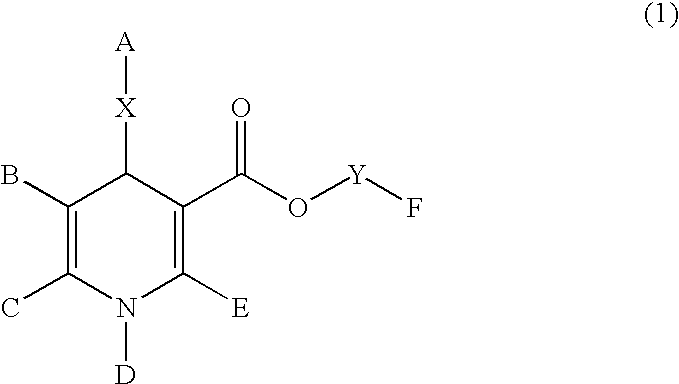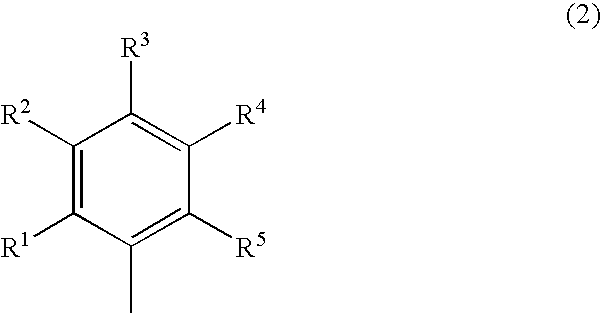Dihydropyridine derivatives
a technology of dihydropyridine and dihydropyridine, which is applied in the direction of biocide, drug composition, cardiovascular disorder, etc., can solve the problem that none of them is actually used as medicin
- Summary
- Abstract
- Description
- Claims
- Application Information
AI Technical Summary
Benefits of technology
Problems solved by technology
Method used
Image
Examples
example 1
Synthesis of mono(3,3-diphenylpropane-1-yl)4-(3-chlorophenyl)-2,6-dimethyl-1,4-dihydropyridine-3,5-dicarboxylate
1) Synthesis of 3-(2-cyanoethyl)5-(3,3-diphenylpropane-1-yl)4-(3-chlorophenyl)-2,6-dimethyl-1,4-dihydropyridine-3,5-dicarboxylate:
[0103]747 mg (2.52 mmol) of 3,3-diphenylpropyl acetoacetate, 389 mg (2.52 mmol) of 2-cyanoethyl 3-aminocrotonate and 0.285 ml (2.52 mmol) of 3-chlorobenzaldehyde were heated at 80° C. under stirring in 20 ml of 2-propanol for two nights. 2-Propanol was evaporated under reduced pressure, and the residue was purified by the silica gel chromatography (hexane / ethyl acetate: 2 / 1) to obtain the title compound.
[0104]Yield: 814 mg (1.47 mmol) (58.3%) MS (ESI, m / z) 553 (M−H)− 1H-NMR (CDCl3): 2.28–2.42 (2H, m), 2.35 (6H, s), 2.64 (2H, t), 3.91 (1H, t), 3.95–4.02 (2H, m), 4.22–4.39 (2H, m), 5.00 (1H, s), 5.73 (1H, s), 7.08–7.30 (14H, m)
2) Synthesis of mono(3,3-diphenylpropane-1-yl)4-(3-chlorophenyl)-2,6-dimethyl-1,4-dihydropyridine-3,5-dicarboxylate:
[0105]...
example 2
Synthesis of mono(2,2-diphenylethyl)4-(3-chlorophenyl)-2,6-dimethyl-1,4-dihydropyridine-3,5-dicarboxylate
1) Synthesis of 2,2-diphenylethyl acetoacetate:
[0107]500 mg (2.52 mmol) of 2,2-diphenylethanol was dissolved in 10 ml of toluene. 382 mg (3.78 mmol) of triethylamine was added to the obtained solution, and they were stirred at room temperature for 1 hour. 386 mg (3.03 mmol) of diketene was added to the obtained mixture under cooling with ice, and then they were stirred under heating at 100° C. for 2 hours. After the addition of saturated aqueous sodium hydrogencarbonate solution followed by the extraction with ethyl acetate, the organic layer was dried over anhydrous sodium sulfate and concentrated under reduced pressure to obtain the unpurified title compound.
[0108]Yield: 831 mg (2.94 mmol) (quantitative yield) MS (ESI, m / z) 281 (M−H)− 1H-NMR (CDCl3): 2.04 (3H, s), 3.34 (2H, s), 4.38 (1H, t), 4.70 (2H, d), 7.18–7.38 (10H, m)
2) Synthesis of 3-(2-cyanoethyl)5-(2,2-diphenylethyl)4-...
example 3
Synthesis of mono(4,4-diphenylbutane-1-yl)4-(3-chlorophenyl)-2,6-dimethyl-1,4-dihydropyridine-3,5-dicarboxylate
1) Synthesis of 1,1-diphenyl-1,4-butanediol:
[0113]60 ml (120 mmol) of 2 M solution of phenyl magnesium bromide in THF was added dropwise to 4.33 g (50.3 mmol) of γ-butyrolactone in 60 ml of THF for the duration of 50 minutes. After stirring at room temperature overnight, a saturated aqueous ammonium chloride solution and then 2 N hydrochloric acid were added dropwise to the reaction mixture. After the extraction with ethyl acetate, the organic layer was dried over anhydrous sodium sulfate and concentrated under reduced pressure to obtain the title compound.
[0114]Yield: 12.24 g (50.5 mmol) (100%) 1H-NMR (CDCl3): 1.58 (2H, qui), 2.42 (2H, t), 3.65 (2H, t), 7.16–7.36 (6H, m), 7.42 (4H, d)
2) Synthesis of 4,4-diphenylbutane-1-ol:
[0115]11.2 g (46.2 mmol) of 1,1-diphenyl-1,4-butanediol was hydrogenated (45° C., 5 atm) in 100 ml of methanol in the presence of 0.5 ml of concentrated...
PUM
| Property | Measurement | Unit |
|---|---|---|
| temperature | aaaaa | aaaaa |
| temperature | aaaaa | aaaaa |
| pressure | aaaaa | aaaaa |
Abstract
Description
Claims
Application Information
 Login to View More
Login to View More - R&D
- Intellectual Property
- Life Sciences
- Materials
- Tech Scout
- Unparalleled Data Quality
- Higher Quality Content
- 60% Fewer Hallucinations
Browse by: Latest US Patents, China's latest patents, Technical Efficacy Thesaurus, Application Domain, Technology Topic, Popular Technical Reports.
© 2025 PatSnap. All rights reserved.Legal|Privacy policy|Modern Slavery Act Transparency Statement|Sitemap|About US| Contact US: help@patsnap.com



